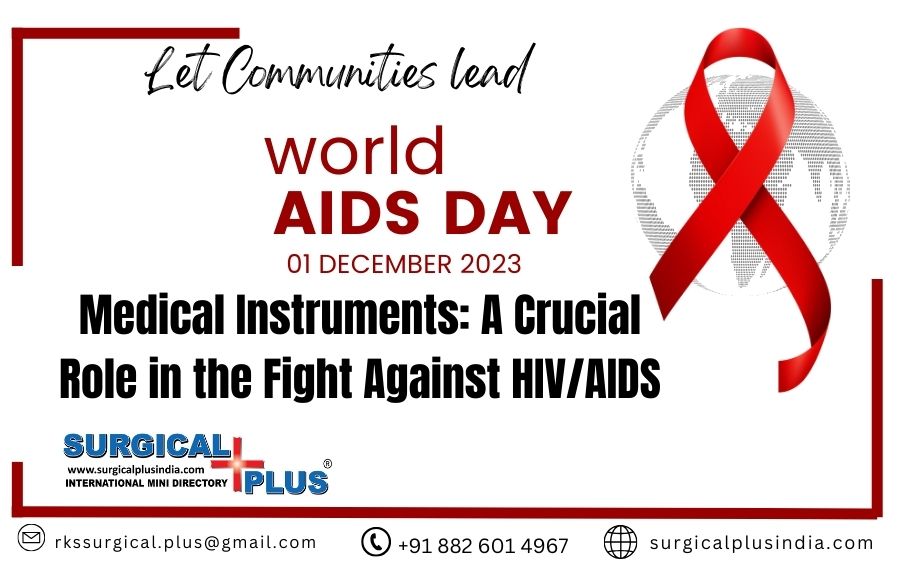Medical Instruments: A Crucial Role in the Fight Against HIV/AIDS
On World AIDS Day, we acknowledge the crucial role of medical advancements in combating HIV/AIDS. Diagnostic techniques like PCR and rapid tests have improved HIV detection. Treatment has evolved with antiretroviral therapy and single tablet regimens, and experimental treatments include therapeutic vaccines and cure-inducing immunotherapies. Surgical interventions assist in diagnosing HIV-related complications. These innovations have transformed HIV/AIDS care, making it a manageable condition for many.

Diagnostic Tools
Early HIV diagnosis is pivotal for effective treatment and prevention. It enables prompt initiation of antiretroviral therapy (ART), suppressing the virus and extending life expectancy. Early ART initiation results in better long-term health outcomes. Moreover, it reduces HIV risk behavior and prevents transmission to others. Hence, increasing testing rates is crucial.
HIV testing has dramatically improved since the 1980s. Initial tests required months for detectable markers, while positive results often necessitated return visits. Fourth-generation tests, available since 2010, reduced the detection window to 2-4 weeks. Today, rapid point-of-care molecular testing is on the horizon. The evolution of HIV self-testing and digital interventions have further enhanced HIV detection.
Medical instruments play a vital role in HIV/AIDS diagnosis. They aid in blood collection, ensuring correct specimen type and adequate quantity. Sophisticated laboratory assays analyze these samples, detecting substances characteristic of HIV. The results are then interpreted, providing an accurate and prompt diagnosis. These steps are critical in HIV prevention and treatment programs.
Treatment Modalities
Antiretroviral therapy (ART) has revolutionized HIV/AIDS treatment. Advancements include single-tablet regimens, simplifying medication adherence. Newer drugs have fewer side effects, improving tolerability. Long-acting ART, taken less frequently, enhances regimen management and reduces drug resistance risk. These developments have made HIV/AIDS a manageable condition for many.
Medical instruments like infusion pumps and auto-injectors play a significant role in administering ART medications. Infusion pumps ensure precise delivery of medication over time, improving treatment effectiveness. Auto-injectors allow for self-administration, enhancing patient adherence to ART regimens. These instruments not only facilitate accurate dosing but also improve patient comfort and autonomy, thereby contributing to the success of HIV/AIDS treatment.
Medical devices significantly contribute to monitoring ART adherence and measuring treatment outcomes. Electronic adherence monitoring (EAM) devices, including mobile phones and electronic monitoring devices, have shown to improve adherence and outcomes across chronic conditions. Technologies like smart pill bottles, smart watches, and wearables provide real-time monitoring of medication-taking behaviors. These devices, combined with interventions that remind the patient in case a deviation is detected, have proven to improve medication adherence. Thus, these technologies play a crucial role in successful implementation of ART in clinical settings.
Surgical Interventions
Surgical interventions are crucial in managing HIV-associated complications. They address opportunistic infections and other AIDS-related conditions. Procedures range from biopsies for diagnosis to major surgeries for complications. With antiretroviral therapy, surgical outcomes have improved, especially in patients without AIDS-related complications or with higher CD4 cell counts. Thus, surgery plays a significant role in comprehensive HIV/AIDS care.
Medical instruments are indispensable in surgical procedures. In laparoscopies, instruments like trocars serve as ports for surgical tools. Devices like forceps, scissors, probes, dissectors, hooks, and retractors are used for precise dissection and control of bleeding. In endoscopies, specialized instruments allow for internal examination, biopsy, and treatment of diseases. Reconstructive surgeries utilize a range of instruments for tissue manipulation and suturing, ensuring precise and safe reconstruction. These instruments have evolved with technology, enhancing surgical outcomes.
Advancing Technology
Telemedicine and mobile health technologies are transforming HIV/AIDS care. They increase access to services, support early diagnosis, treatment initiation, and sustained viral suppression. These technologies also enable real-time monitoring of medication adherence, making them instrumental in managing HIV/AIDS, especially in remote areas.
Artificial Intelligence (AI) and Machine Learning (ML) have shown great potential in HIV/AIDS care. They enhance diagnosis through sophisticated algorithms, improve treatment monitoring by predicting viral load, and facilitate patient education via chatbots. These technologies are revolutionizing HIV/AIDS prevention and treatment.
Continued innovation and collaboration are essential to develop next-generation medical instruments for HIV/AIDS care. These advancements will enhance diagnosis, treatment, and patient outcomes, paving the way for a future free from HIV/AIDS.
Conclusion
Medical instruments play a pivotal role in combating HIV/AIDS, from diagnosis to treatment. Despite advancements, challenges persist, underscoring the need for continued investment in research and development. We pledge to support initiatives that enhance access to quality medical instruments worldwide, reinforcing our commitment to a future free from HIV/AIDS.
